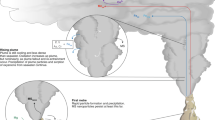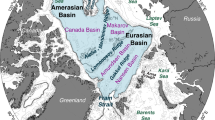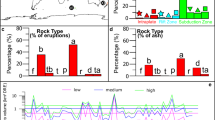Abstract
Understanding the nature and rates of processes by which materials are transported and mixed in the deep ocean is essential for evaluating environmental effects and risks involved in human uses of the ocean, such as mining of manganese nodules and deep ocean dumping of wastes. I report here the first measurements of 227 Ac (half life, t1/2, 21.8 yr) in seawater. The results clearly show the presence of excess 227 Ac relative to its progenitor 231Pa (see Fig. 1) in deep waters below 3 km, suggesting that the 227 Ac is supplied by diffusion from sediments. Two other natural radionuclides, 222Rn (ref. 1) and 228Ra (ref. 2) which have bottom sources, have proved to be useful for determining rates of mixing from days to decades. The excess 227 Ac can be used as a novel tracer for basin-wide circulation and mixing on time scales up to 100 yr.
This is a preview of subscription content, access via your institution
Access options
Subscribe to this journal
Receive 51 print issues and online access
$199.00 per year
only $3.90 per issue
Buy this article
- Purchase on Springer Link
- Instant access to full article PDF
Prices may be subject to local taxes which are calculated during checkout
Similar content being viewed by others
References
Broecker, A. S. in Symp. on Diffusion in Oceans and Fresh Waters (ed. Ichiye, T.) 116–145 (Lament-Doherty Geological Observatory, Palisades, 1965).
Moore, W. S. & Sackett, W. M. J. geophys. Res. 69, 5401–5405 (1964).
Horibe, Y. (ed.) Preliminary Report of the Hakuho Maru Cruise KH-80-2 and KH-82-1 (Ocean Research Institute, University of Tokyo, 1983).
Nozaki, Y. & Horibe, Y. Earth planet. Sci. Lett. 65, 39–50 (1983).
Amin, B. S., Krishnaswami, S. & Somayajulu, B. L. K. Earth planet. Sci. Lett. 21, 342–344 (1974).
Anderson, R. F. & Fleer, A. P. Analyt. Chem. 54, 1142–1147 (1982).
Latimer, W. M. Oxidation Potentials 2nd edn (Prentice Hall, New Jersey, 1952).
Klinkhammer, G., Elderfield, H. & Hudson, A. Nature 305, 185–188 (1983).
Cochran, J. K. thesis, Yale Univ. (1979).
Kaufman, A., Trier, R. M. & Broecker, W. S. J. geophys. Res. 78, 8827–8848 (1973).
Li, Y. H., Feely, H. W. & Toggweiler, J. R. Deep Sea Res. 27, 545–555 (1980).
Nozaki, Y., Tsubota, H. & Horibe, Y. Earth planet. Sci. Lett. 54, 203–216 (1981).
Sarmiento, J. L., Feely, H. W., Moore, W. S., Bainbridge, A. E. & Broecker, W. S. Earth planet. Sci. Lett. 32, 357–370 (1976).
Armi, L. J. mar. Res. 37, 515–530 (1979).
Broecker, W. S. & Peng, T. H. Tracers in the Sea (Eldigio, Palisades, 1982).
Author information
Authors and Affiliations
Rights and permissions
About this article
Cite this article
Nozaki, Y. Excess 227Ac in deep ocean water. Nature 310, 486–488 (1984). https://doi.org/10.1038/310486a0
Received:
Accepted:
Issue Date:
DOI: https://doi.org/10.1038/310486a0
This article is cited by
-
Determination of 227Ac in water by alpha spectrometry after purification with titanium phosphate and DGA resin
Journal of Radioanalytical and Nuclear Chemistry (2022)
-
Liquid scintillation counting of environmental radionuclides: a review of the impact of background reduction
Journal of Radioanalytical and Nuclear Chemistry (2016)
-
A new method for the determination of low-level actinium-227 in geological samples
Journal of Radioanalytical and Nuclear Chemistry (2013)
-
A method for separation of Po, Th, Pa and U in high yields from various matrices
Journal of Radioanalytical and Nuclear Chemistry Articles (1992)
-
Seasonal effects on the intensity of natural background gamma radiation spectrum
Journal of Radioanalytical and Nuclear Chemistry Articles (1989)
Comments
By submitting a comment you agree to abide by our Terms and Community Guidelines. If you find something abusive or that does not comply with our terms or guidelines please flag it as inappropriate.



